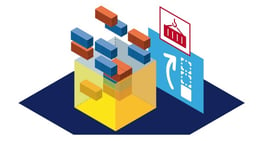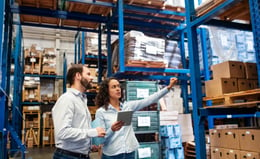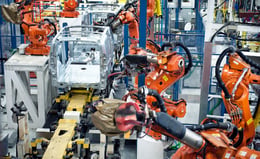Is Your Supply Chain Ready for Logistics 4.0?
Brian Hoey - November 01, 2018

![]()
 In a recent Seattle Times Article, readers got an intimate account of how Cloudburst Brewing creates its seasonal fresh hop beers. While most hops used in beer production are dried before they’re shipped from the farm, fresh hop beers utilize fresh-picked, “wet” hops that haven’t been dried yet. As such, this popular style can only be brewed during and immediately after the annual hop harvest, and only under ideal conditions. A traffic jam, a flat tire, or a power outage at the brewing facility could jeopardize brewers’ efforts, owing to the extremely short shelf-life that these “wet” hops have.
In a recent Seattle Times Article, readers got an intimate account of how Cloudburst Brewing creates its seasonal fresh hop beers. While most hops used in beer production are dried before they’re shipped from the farm, fresh hop beers utilize fresh-picked, “wet” hops that haven’t been dried yet. As such, this popular style can only be brewed during and immediately after the annual hop harvest, and only under ideal conditions. A traffic jam, a flat tire, or a power outage at the brewing facility could jeopardize brewers’ efforts, owing to the extremely short shelf-life that these “wet” hops have.
In the Seattle Times piece, we see Cloudburst head brewer Steve Luke driving to a Yakima Valley hop farm himself and coordinating with his associates back at the brewery to ensure that the hops can be utilized the very minute they’re loaded out of his van. This means that Luke is sending status updates constantly, which the other brewers must constantly check against their production plans to ensure that the “boil” (the part of the brewing process where the hops typically come into play) happens just as the hops are arriving. This means a lot of texts back and forth, with Luke giving traffic updates and his team making adjustments accordingly.
Ultimately, the hops arrive in time and the beer is a success, but any supply chain planners out there might have been holding their breath. Why? Because they know how easily something can go wrong under these circumstances, especially when so much communication and coordination is being performed manually. Of course, this is a small craft brewery, rather than, say, a large automotive manufacturer—but it still highlights the challenges of effective logistics management, especially in a non-digital environment.
The Changing Face of Transport Logistics
Depending on how similar the brewery’s process is to what your business goes through in its average transport logistics operation, your supply chain may or may not be ready for the rise of Logistics 4.0. For the uninitiated, Logistics 4.0 involves applying Industry 4.0 principles of connectivity and digitization to transport logistics. In this way, IoT devices, RFID chips, smart containers, smart pallets, and smart ports all playing a role in the creation of a more cohesive value chain. Perhaps because these new workflows can alleviate the pain points associated with low visibility and data silos (from inefficient routing to late deliveries due to static transport plans), Logistics 4.0 is increasingly becoming a major value-added proposition and a real competitive advantage. But how can you determine if your supply chain is ready to take advantage of these new digital shipping processes?
Creating a Digital Paper Trail
To begin with, you'll want to assess how much of your logistics infrastructure is already digital. Do you have a digital workflow for transport order creation? What about for the creation of transport networks and routes? Order statuses? Proof of delivery? These things might not seem monumental on their own, but taken as a whole they form the basis of a powerful digital logistics paradigm. Why? Because Logistics 4.0 depends on making processes and data available in a digital environment. Let’s say you’re arranging the transport of goods from one warehouse to another: you have a truck equipped with RFID chips for real-time traffic, and you have a telematics system in place that enables you to communicate dynamic route changes to your driver in real time based on incoming traffic and weather reports. In a Logistics 4.0 environment, these are crucial ways to add value through agility and visibility, but if you don’t have a digital transport order or inventory list that can map the transport process onto the actual order that it corresponds to, then from an organizational standpoint you’ve missed an important piece of the puzzle. You may get your goods from one place to another more efficiently, but you won’t be able to say with any certain which goods got moved, when they were transported, or when the delivery was completed because there was no digital transport order to connect the information to.
The problem described in the above paragraph can also be applied fairly easily to the next item on our checklist: data availability. To wit, if you do have digital orders, for instance, but they’re locked in a data silo, then you’re in virtually the same position as if you only had pen and ink orders. For this reason, breaking down data silos is one of the key strategies for preparing your company for the realities of Logistics 4.0. It’s not necessarily an easy process (many businesses will have to deal with legacy IT systems that can be difficult to either upgrade or integrate into other digital supply chain workflows), but the results can help pave the way for more impressive things like advanced analytics and other automated workflows.
Putting Quality Data to Use
Once your value stream is steeped in digital technology, boasting highly visible digital order data, route and tour information, and customer requirements, the next step in building towards a Logistics 4.0 framework is to put that data to work. How? By leveraging exactly the predictive and prescriptive supply chain analytics and process automation tools we alluded at the end of the last paragraph. Instead of using past data on its own to inform your logistics decision-making (which can lead to shortsighted plans that don’t account for future demand changes), you can use your existing information (alongside real-time data integration) to feed advanced predictive algorithms that can sense changing demand far in advance. In this way, rather than static plans that turn into shortages or overages when demand levels aren’t as expected, you can leverage a more adaptable supply chain to head off these kinds of disruptions before they happen. To think back to our brewery example, this process might enable planners to proactively schedule boil times based on data about how long the trip back from the hop farm usually takes combined with real-time cargo tracking and traffic data, thereby taking some of the guesswork and much of the back-and-forth out of the equation.
The workflow described above might seem in some ways like it’s essentially a standalone process, representing the power of predictive analytics based on high quality data, but in fact it’s much more than that. The agility alluded to above is a symbol of what makes Logistics 4.0 possible. As you consider steps for making your supply chain Logistics 4.0-ready, consider how much agility and flexibility your operations already have, and then ask yourself, “what steps can I take to bolster those levels?”
LATEST POSTS
- Understand Why Production Planning Needs Specialized Solutions
- Understand Circular Economy in The Manufacturing Industry
- How Can Industry 4.0 IT Integration Be Achieved Smoothly?
- The Significance of Order Sequencing in Discrete Manufacturing
- How to improve your Supply Chain Management: The Power of Control Towers



